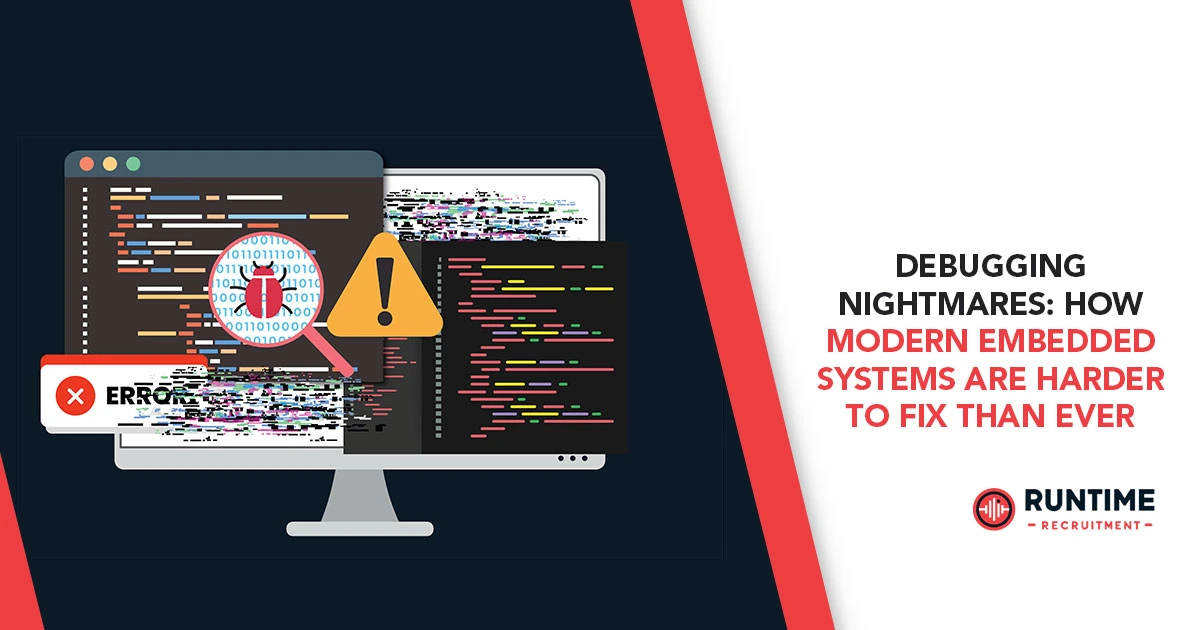The embedded world, once a realm of relatively simple microcontrollers and straightforward code, has exploded into a dizzying landscape of complexity. Today’s embedded systems are powerhouses of innovation, driving everything from self-driving cars and medical implants to smart home devices and industrial robots. Yet, beneath the sleek surfaces and impressive functionalities lies a brutal truth for the engineers who build them: debugging modern embedded systems is a nightmare, arguably harder than ever before.
Gone are the days when a simple LED blink or a printf statement to a serial console could reliably pinpoint an issue. The intricate interplay of hardware and software, the relentless pursuit of real-time performance, the constraints of power and memory, and the insidious rise of concurrency issues have collectively transformed debugging from a challenging task into a veritable art form, demanding not just technical prowess but also a detective’s intuition and a monk’s patience.
The Unseen Enemy: Limited Visibility
One of the most fundamental hurdles in embedded debugging is the inherent lack of visibility into the system’s internal state. Unlike desktop applications where robust operating systems provide ample debugging hooks, logs, and interactive development environments, embedded systems often operate in resource-constrained environments with minimal to no user interface.
- Bare-metal Black Boxes: Many embedded systems run on bare metal, meaning there’s no underlying operating system to provide services like file logging or extensive memory management. When a crash occurs, you’re often left with a blank screen and little to no information about what went wrong.
- Resource Constraints: Limited RAM and flash memory often preclude the inclusion of extensive debugging code, large log buffers, or even sophisticated debugging libraries. Every byte counts, and debugging features are often the first to be sacrificed in the name of performance or size.
- Real-time Imperatives: The very nature of real-time embedded systems—where events must be processed within strict deadlines—makes traditional debugging intrusive. Pausing execution with a breakpoint can alter timing, masking the very issue you’re trying to find or introducing new, transient bugs. Stepping through code often changes the timing significantly, making it impossible to reproduce subtle race conditions or intermittent failures.
- The Elusive Nature of the Bug: Sometimes, a bug only manifests under very specific, rare conditions that are incredibly difficult to reproduce in a controlled environment. Temperature fluctuations, power supply glitches, external electromagnetic interference, or specific sequences of user inputs can trigger faults that remain hidden during standard testing.
Hardware-Software Tango: A Choreography of Chaos
Modern embedded systems are a tightly coupled dance between hardware and software. A bug might not reside neatly in one domain but could be a complex interplay of both, making root cause analysis exceptionally difficult.
- Interdependent Faults: A software bug might expose a latent hardware design flaw, or a hardware issue might cause seemingly random software errors. For instance, a marginal power delivery network might cause an otherwise stable microcontroller to glitch under heavy load, leading to a software crash that appears to be a memory corruption issue.
- Peripheral Initialization and Configuration: Incorrectly initializing or configuring a peripheral, even by a single bit, can lead to unpredictable behavior. Debugging these issues often requires poring over lengthy datasheets, register maps, and application notes, hoping to spot a subtle discrepancy.
- Signal Integrity and Timing: As clock frequencies increase and signal rise/fall times shrink, signal integrity becomes paramount. Crosstalk, reflections, impedance mismatches, and power supply noise can corrupt digital signals, leading to erroneous data transfers or missed interrupts. Debugging these issues often necessitates high-end oscilloscopes, logic analyzers, and spectrum analyzers, requiring expertise in both electrical engineering and software.
- The Analog-Digital Divide: Many embedded systems interact with the physical world through analog sensors and actuators. Debugging issues at this interface, such as sensor calibration errors, analog-to-digital converter (ADC) inaccuracies, or noisy analog signals affecting digital readings, bridges the gap between traditional software debugging and analog circuit analysis.
The Concurrency Conundrum: When Time Becomes a Variable
The advent of multi-core processors and complex real-time operating systems (RTOS) has ushered in a new era of concurrency, bringing with it a fresh set of debugging challenges.
- Race Conditions: When multiple threads or tasks access shared resources without proper synchronization, race conditions can occur, leading to unpredictable behavior. These bugs are notoriously difficult to reproduce because their manifestation depends on the precise timing of events, which can vary subtly with each execution.
- Deadlocks: Two or more tasks waiting indefinitely for each other to release a resource can lead to a system deadlock, effectively freezing the system. Identifying the culprit tasks and the resource contention points requires sophisticated tools and a deep understanding of RTOS scheduling.
- Priority Inversion: A higher-priority task can be blocked by a lower-priority task holding a required resource, leading to critical timing violations. This insidious problem can be extremely difficult to diagnose without dedicated RTOS-aware debugging tools that can visualize task states and resource ownership.
- Stack Overflows and Heap Corruption: With multiple tasks, each with its own stack, managing memory becomes critical. Stack overflows can occur when a task consumes more stack space than allocated, leading to crashes or unpredictable behavior. Heap corruption, often caused by incorrect memory allocation/deallocation, can manifest as seemingly random data corruption, making the root cause almost impossible to trace without specialized memory debugging tools.
The Shadow of Security: Debugging in a Hostile Environment
The increasing connectivity of embedded systems has introduced a new layer of complexity: security. Debugging often involves probing the system at a low level, which can expose vulnerabilities or be hindered by security mechanisms.
- Secure Boot and Firmware Protection: Modern systems often employ secure boot mechanisms and firmware encryption to prevent unauthorized access or modification. While essential for security, these features can make it harder to load custom debug firmware or gain visibility into the boot process.
- Anti-Tampering Measures: Devices in sensitive applications (e.g., medical, financial) may have anti-tampering features that detect attempts to access internal components, potentially erasing data or bricking the device if triggered. This significantly complicates invasive debugging.
- Cryptographic Overhead: Incorporating cryptography adds computational overhead and introduces new potential failure points related to key management, secure storage, and cryptographic algorithm implementations, all of which require specialized debugging techniques.
The Modern Toolkit: Not a Panacea
While debugging tools have evolved, they often struggle to keep pace with the accelerating complexity.
- In-Circuit Emulators (ICE) and JTAG/SWD: These hardware debuggers provide unparalleled visibility and control, allowing engineers to set breakpoints, step through code, and examine registers. However, their effectiveness can be limited in complex multi-core systems, or when dealing with highly optimized code that rearranges instructions. Furthermore, some modern microcontrollers are opting for more constrained debug interfaces to reduce pin count and cost, offering less visibility than their predecessors.
- Logic Analyzers and Oscilloscopes: Indispensable for hardware-software co-debugging and signal integrity analysis, these tools can reveal timing issues and protocol errors. However, interpreting complex digital bus waveforms or identifying subtle analog glitches requires significant expertise and often high-end, expensive equipment.
- Software Debuggers and IDEs: Integrated Development Environments (IDEs) with built-in debuggers offer a familiar interface for software debugging. However, their capabilities are often limited to the software domain and may not provide sufficient insight into hardware interactions or real-time nuances.
- Trace Tools: Advanced trace capabilities, such as instruction trace (ETM/PTM) or data trace, can record system behavior non-intrusively. This provides a invaluable “flight recorder” view of what happened leading up to a crash. However, trace buffers are finite, and interpreting vast amounts of trace data can be a daunting task, often requiring specialized analysis tools.
- Virtualization and Simulation: Simulators and emulators can be powerful for early-stage debugging and reproducing hard-to-find bugs. However, they can never perfectly replicate the real-world hardware, and subtle hardware-specific issues might only appear on the actual target.
The Path Forward: Strategies for Survival
Given these escalating challenges, embedded engineers must adopt a multifaceted approach to debugging.
- Design for Debuggability:
- Modular Architecture: Breaking down the system into smaller, testable modules makes isolation easier.
- Logging and Telemetry: Strategically placed logging mechanisms, even if minimal, can provide invaluable clues. Consider using lightweight logging frameworks that minimize overhead.
- Diagnostic Features: Build self-test routines, error codes, and health monitoring into the firmware from the outset.
- Debug Pins and Test Points: Design the hardware with accessible debug headers and test points for critical signals.
- Embrace Advanced Tools:
- High-End Debug Probes: Invest in robust hardware debuggers with advanced features like complex breakpoints, data watchpoints, and real-time trace capabilities.
- Mixed-Signal Oscilloscopes (MSOs) and Logic Analyzers: These are essential for debugging hardware-software interactions and timing issues.
- Protocol Analyzers: For complex communication protocols (e.g., USB, Ethernet, CAN, I2C, SPI), protocol analyzers can decode traffic and identify errors.
- RTOS-Aware Debuggers: Tools that integrate with your chosen RTOS can visualize task states, mutex ownership, and message queue contents, significantly aiding in concurrency debugging.
- Systematic Troubleshooting:
- Reproduce, Isolate, Analyze, Fix, Verify: Adhere to a rigorous debugging methodology. Consistent reproduction is key.
- Divide and Conquer: Systematically eliminate possibilities by commenting out code, disabling peripherals, or simplifying the test case.
- Version Control and Regression Testing: Utilize robust version control systems (e.g., Git) to track changes and enable quick rollbacks. Implement automated regression tests to prevent previously fixed bugs from reappearing.
- Invest in Expertise and Collaboration:
- Multidisciplinary Knowledge: A strong understanding of both hardware and software is increasingly crucial.
- Knowledge Sharing: Foster an environment where engineers share debugging experiences, tips, and custom tools. Pair debugging can be highly effective.
- Continuous Learning: Stay updated on new debugging techniques, tools, and best practices.
The Future of Debugging: Hope on the Horizon?
While the challenges are formidable, the embedded community isn’t static. Several trends offer glimmers of hope:
- AI-Assisted Debugging: AI and machine learning could potentially analyze vast amounts of trace data, identify patterns, and even suggest potential root causes or fixes. LLMs might assist in generating debugging code or interpreting cryptic error messages.
- Enhanced Virtualization and Digital Twins: More accurate and comprehensive simulation environments, coupled with “digital twins” that perfectly mirror physical systems, could shift a significant portion of debugging to the virtual realm, reducing reliance on physical hardware.
- Non-Intrusive Monitoring: Advancements in non-intrusive monitoring technologies, perhaps utilizing optical or electromagnetic sensing, could provide deeper insights into system behavior without altering its real-time characteristics.
- Standardized Debug Interfaces: While challenging, greater standardization of debug interfaces and protocols across different vendors could streamline tool development and improve interoperability.
- Security-Aware Debugging Tools: Debugging tools designed with security in mind, offering secure access and analysis capabilities without compromising the system’s integrity, will become essential.
Conclusion: A Noble Pursuit
Debugging embedded systems has always been a demanding profession, a crucible where theoretical knowledge meets the harsh realities of hardware imperfections and software complexities. In the era of increasingly sophisticated and interconnected embedded devices, the “debugging nightmare” is more pronounced than ever. It demands a new breed of embedded engineer – one who is not only a master of code and circuits but also a relentless problem-solver, a patient investigator, and an ardent learner.
The bugs may be harder to find, more elusive, and more catastrophic in their impact, but the satisfaction of coaxing a complex embedded system from erratic behavior to flawless operation remains one of the most rewarding experiences in engineering. For those who dare to dive into the depths of these modern debugging nightmares, the journey is arduous, but the triumph is uniquely profound.









